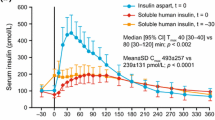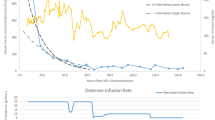Abstract
The control of severe hypoglycemic symptoms in patients with insulin-secreting islet tumors (insulinoma) of the pancreas is an important aspect of management. A series of 24 patients with insulinomas whose ages ranged from 5 months to 73 years seen at one center over a period of 17 years is described. The presenting symptoms and the effect of these on their lifestyles are discussed. Diazoxide has been used to control hypoglycemic symptoms in 18 of the 24 patients. Fourteen patients have received diazoxide for varying periods of time prior to successful surgery and 4 have received long-term therapy. Three of these patients are highlighted to show various aspects of benefit and problems from the use of diazoxide. The mean dosage of diazoxide was 400 mg/day and the mean duration of therapy was 10 months. The control of symptoms was good in 8, fair in 6, and poor in 4. The main side effects observed were hirsutism (56%), ankle edema (50%), weight gain (38%), and nausea (11%). These side effects were well tolerated and the benefits of therapy were felt to outweigh disadvantages. Side effects only necessitated discontinuation of diazoxide in 1 patient who developed a severe hypersensitivity reaction. Our results show that diazoxide has a role to play in the management of patients with insulinoma during preoperative tumor localization and can also be used when surgery is contraindicated or when laparotomy is unsuccessful.
Résumé
Le contrôle des symptômes de l'hypoglycémie grave chez les sujets porteurs d'un insulinome pancréatique occupe une place essentielle dans le traitement de l'affection. Chez 24 malades dont l'âge allait de 5 mois à 73 ans et qui furent observés dans un même centre au cours d'une période de 17 ans, les troubles qu'ils accusèrent et le retentissement de ceux-ci sur leur vie font l'objet de cette étude. Chez 18 d'entre eux la diazoxide a été employée 14 fois avant l'intervention pendant une période variable et 4 fois pendant une période prolongée. Trois de ces cas ont été étudiés particulièrement pour montrer les différents aspects bénéfiques et les différents problèmes dûs à l'emploi de la diazoxide. La diazoxide fut administrée à la dose de 400 mg par 24 heures pendant une période moyenne de 10 mois. Les résultats furent bons, moyens et médiocres dans respectivement 8, 6, et 4 cas. Les principaux effets secondaires défavorables furent l'hirsutisme (56%), l'oedème de la cheville (50%), l'augmentation du poids (38%), la nausée (11%). Ces effets secondaires furent cependant bien tolérés et au total les avantages du traitement sont supérieurs à ses désavantages. C'est seulement chez un seul malade que le traitement dû être interrompu en raison d'une hypersensibilité sévère au médicament. Ces résultats démontrent que la diazoxide possède une place dans le traitement préopératoire de l'hyperinsulinisme avant la localisation de la tumeur. Elle est aussi indiquée lorsque la chirurgie ne peut être envisagée en raison d'une contre-indication ou lorsque la laparotomie ne permet pas de découvrir la lésion.
Resumen
El control de los síntomas hipoglicémicos es un aspecto importante en el manejo de pacientes con tumores insulares secretores (insulinomas) del páncreas. Se describe una serie de 24 pacientes con insulinomas con edades entre 5 meses y 73 años vistos en un centro médico a lo largo de un perído de 17 años. Se analizan los síntomas que motivaron su presentación y el efecto de éstos sobre los hábitos de vida. El diazóxido fue usado en el control de los síntomas hipoglicémicos en 18 de 24 pacientes. Catorce pacientes recibieron diazóxido por períodos variables antes de ser sometidos a cirugía exitosa y 4 lo han recibido como terapia de largo plazo. Tres de estos son presentados en forma destacada para demostrar diversos aspectos del beneficio y de los problemas encontrados con el uso del diazóxido. La dosis promedio de diazóxido fue de 400 mg diarios y el promedio de duración de la terapia fue de 10 meses. El control de los síntomas apareció como bueno en 8 casos, regular en 6, y pobre en 4. Los principales efectos colaterales observados fueron el hirsutismo (56%), el edema del tobillo (50%), el aumento de peso (38%), y la náusea (11%). Estos efectos colaterales fueron bien tolerados y se consideró que los beneficios de la terapia sobrepasaron las desventajas. Los efectos colaterales hicieron necesario descontinuar el diazóxido sólo en un paciente que desarrolló una severa reacción de hipersensibilidad. Nuestros resultados muestran que el diazóxido tiene un lugar definido en el manejo de pacientes con insulinoma en la localización preoperatoria del tumor y puede ser utilizado cuando la cirugía está contraindicada o cuando la laparotomía no ha sido exitosa.
Similar content being viewed by others
References
Finnerty, F.A.: Discussion in Hypertension: The First Bahnemann Symposium on Hypertensive Disease, J.H. Moyer, editor. Philadelphia, W.B. Saunders, 1959, p. 653
Wolff, F.W.: Clinical and physiological implications of diabetes induced by benzothiadiazines. Diabetes13:203, 1964
Loubatieres, A., Mariani, M.M., Alric, R.: Action of diazoxide on insulin secretion, medulla adrenal secretion and liberation of catecholamines. Ann. N.Y. Acad. Sci.150:226, 1968
Graber, A.L., Porte, D., Williams, R.H.: Clinical use of diazoxide and studies of the mechanisms of its hyperglycemic effects in man. Ann. N.Y. Acad. Sci.150:303, 1968
Marks, V., Samols, E.: Diazoxide therapy of intractable hypoglycemia. Ann. N.Y. Acad. Sci.150:442, 1968
LeQuesne, L.P., Nabarro, J.D.N., Kurtz, A., Zweig, S.: Management of insulin tumours of the pancreas. Br. J. Surg.66:373, 1979
Marks, V., Samols, E.: Insulinomas, natural history and diagnosis. Clin. Gastroenterol.3:559, 1974
Stefanini, P., Carboni, M., Patrassi, N., Basoli, A.: B islet cell tumors of the pancreas: Results of a study of 1,067 cases. Surgery75:597, 1974
Turner, R.C., Oakley, N.W., Nabarro, J.D.N.: Control of basal insulin secretion with special reference to insulinomas. Br. Med. J.1:132, 1971
van Heerden, J.A., Edis, A.J., Service, F.J.: Surgical aspects of insulinomas. Ann. Surg.189:677, 1979
Galbut, D.L., Markowite, A.M.: Insulinoma: Diagnosis, surgical management and long-term follow-up. Am. J. Surg.139:682, 1980
Kaplan, E.L., Lee, C.H.: Recent advances in diagnosis and treatment of insulinomas. Surg. Clin. North Am.59:1, 1979
Dagget, P.R., Kurtz, A.B., Morris, D.V., Goodburn, E.A., LeQuesne, L.P., Nabarro, J.D.N., Raphael, M.J.: Is pre-operative localization of insulinomas necessary? Lancet1:483, 1981
Madsen, B., Skjoldborg, H.: Preoperative localization of insulinomas. Lancet1:954, 1981
Laroche, G.P., Ferris, D.O., Priestley, J.T., Scholz, D.A., Dokerty, D.B.: Hyperinsulinism—surgical results and management in 154 cases. Arch. Surg.96:763, 1978
D'Arcuanges, C.M., Awoke, S., Lawrence, G.D.: Metastatic insulinoma with long survival and glucagonoma syndrome. Ann. Intern. Med.100:223, 1984
Burch, P.G., McLeskey, C.H.: Anaesthesia for patients with insulinoma treatment with oral diazoxide. Anaesthesiology55:472, 1981
Author information
Authors and Affiliations
Rights and permissions
About this article
Cite this article
Goode, P.N., Farndon, J.R., Anderson, J. et al. Diazoxide in the management of patients with insulinoma. World J. Surg. 10, 586–591 (1986). https://doi.org/10.1007/BF01655532
Issue Date:
DOI: https://doi.org/10.1007/BF01655532




